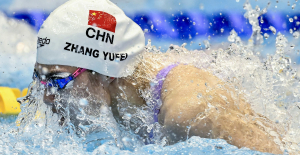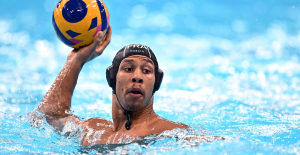Martinique without rum is possible, but it's a crazy idea - this realization dawns on you at the latest in the dimly lit treasury of Trois Rivières in Maison La Mauny. Daniel Baudin personally welcomes his guests in the maturing cellar of the 300-year-old rum distillery. A man with gray hair and a soft voice, who occasionally peers through his glasses inquiringly; as if he wants to make sure that the group really takes this visit seriously.
There is no doubt about Baudin's seriousness: the barrel master has been in his profession for a good three decades, and he has been at the International Wine several times
It takes a lot of effort to tell him that there are also visitors who only want to watch the following item on the program because they don't drink alcohol. Baudin doesn't change his face: "We don't drink alcohol," he replies gently. "We taste it."
You have to know that a trip to Martinique means pure Romance. That's right, with U. According to holidaymakers and locals alike, there's only one thing better than rum, and that's rum on the beach. The island of the Lesser Antilles has around 100 of these, with either white or volcanic ash black sand.
The coast is never more than twelve kilometers away at any point on the island – to the southwest is the Caribbean Sea, to the northeast is the Atlantic. So visitors only have to find a nice spot next to a beach bar to indulge in one, two, many "ti punches" (about five centilitres of white rum, a teaspoon of cane sugar, a crushed quarter of a lime, no ice).
But what if you don't drink alcohol? What is there to experience if the program item of punch and splashing is left out - in order to embark on a sober journey across the island?
Martinique is not even half the size of Saarland, which makes it easy to let yourself drift. It's basically enough to be swept out of the bustling main town of Fort-de-France in a rental car and washed up somewhere between rainforests and rainbows, mountains and coasts. From sunrise on the beach, where the villagers pull the fishing nets out of the sea together, to sunset in Saint-Pierre, at the foot of the Montagne Pelée.
Sooner or later, however, nobody can avoid rum, it is simply too important for that - culturally, culinary and economically. A total of 17 million liters are produced on Martinique every year, and there are no fewer than seven distilleries on the small island. There, visitors on rum tours can learn how the sugar cane is harvested, chopped, filtered, fermented, distilled, reduced and finally stored.
That morning, Baudin set up a minibar in his kingdom on two barrels, with around half a dozen different types of rum on it: from white to brown, from young to old. Rum needs "Passion, Patience, Partage" is written on a plaque behind him: passion, patience, participation.
And visitors should definitely take part when Daniel Baudin initiates the high art of tasting. Even if you don't drink, because between barrels and shop talk you can learn a lot about the history and present of the island.
But that's not all. If Baudin has his way, a rum tasting is like a first date: "You have to get involved step by step, take in the mood." A motto that not only allows you to explore high-proof spirits much more intensively. Look, sniff, taste - here are instructions on how to discover Martinique with all your senses.
Baudin starts with a thorough inspection. The rum expert hands out tasting glasses, takes turns pouring, grabs one of the tulip-shaped vessels and examines the liquid critically: "Very clear, silvery reflections".
Then he holds his glass almost horizontally, gently turns it around its own axis and straightens it up again – so that the oily patina, which is now wetting the inside of the glass, runs down again. The slower the rum flows, the higher its alcohol content. Baudin calls this test "making the glass cry".
An ambiguous formulation, one thinks, because the history of rum, like that of the island, is inextricably linked to slavery. Not far from La Mauny is the open-air museum "La Savane des Esclaves", which recreates 400 years of history in two dozen thatched huts - starting with the Kalinago indigenous people, wiped out by European conquerors in the 17th century.
However, the largest part is dedicated to the approximately 60,000 people who were abducted from Africa, tortured on plantations or killed - and from whom 80 percent of the current population of Martinique descend.
Anyone who has visited the museum will actually see “Madinina”, as the natives called their island, with different eyes. On the one hand, because this island was not paradise for centuries, but hell.
On the other hand, because if you take a closer look you can still see wounds from that time. There are, for example, the empty plinths in the park and in front of the Palace of Justice in Fort-de-France. Statues of Joséphine de Beauharnais, Napoleon's wife, and Victor Schoelcher, initiator of the 1848 decree abolishing slavery, once stood there.
Both monuments were recently toppled. The Empress for supporting slavery; the politician because he had approved compensation for the colonial masters with the decree. Their descendants make up barely one percent of the population today, but still own half of the lands and dominate agriculture.
This look at history explains why Martinique is part of the European Union - and why Germans can enter with an ID card. The residents counter the ambivalent status as a French overseas territory with a good dose of Creole pride. It starts with their everyday language, a mix of African, European and Caribbean influences, which even Francophone visitors can hardly understand a word of.
Martinique's rise to become a rum stronghold is also rooted in its colonial past: Christopher Columbus brought sugar cane to the Caribbean and landed on Martinique in 1502. The plant stalks provided sugar, and the intoxicating effect of the fermented and burned sugar cane juice did not remain hidden from the colonists for long.
In the 1749 distillery, rum master Daniel Baudin instructs his group on the next step in the tasting: the smell test. The expert guides his glass in front of the chest, under the chin, then under the nose, from left to right, from right to left - and alternately holds one nostril. Each of the two openings, he explains, perceives different smells: one side, for example, floral notes, the other the fruity ones.
For beginners, all rums smell pretty much the same, no matter which nostril you use. Only after a few deep breaths do you think you can catch nuances; sometimes for wood, then again for honey. But that can also be due to the oak barrels and the sweet vapors that waft over the distillery.
Nevertheless, Baudin's words echo in the ear, even later in the covered market of Fort-de-France - because if anywhere in Martinique it takes special sniffing skills to find your way through a thicket of scents, then here it is.
A taster tour along the stands, through a cloud of turgid aromas: here the vanilla pods, there the cinnamon sticks, there the cocoa. Bags of earth-colored powders are stacked on checked oilcloth: nutmeg, chili, curry, turmeric, pepper. After the detour to the fruit, past mountains of ripe bananas, guavas and passion fruit, the market visitors stagger onto the street and take a deep breath. So this is what an olfactory pressure refueling feels like.
A stroll through the Jardin Créole, just under an hour's drive south-east of Fort-de-France on the heights of Le Marin, is just as intense. There, Monique Céphise transformed the family garden, which her great-grandfather planted in 1852, into a herbarium. It follows a circular route across the four hectares of land, past mahogany trees. Creepers thick as ropes. Orchids thrive in pink.
In her garden, however, medicinal plants are the real stars. Of the more than 600 plants that are pharmaceutically approved in the country, 450 sprout on the island - Martinique is also called the "pharmacy of France" by locals. An acanthus plant with the beautiful name "Justicia secunda" lowers high blood pressure; Anise verbena helps with colds; the scarlet colquhounia is called "paracetamol plant" because it reduces fever and pain.
Monique Céphise shows, picks and rubs leaves between her fingers. This journey also smells like this: of essential oils, citrus, mint. The gardener knows every plant by name. She cherishes the family inheritance together with a team, but also lends a hand herself - "every day, otherwise the garden is getting too big for me".
And just when people are wondering how she manages to do it, she points to the pods of a climbing plant: "It takes nine months for vanilla pods to ripen, like a baby's," she says with a smile. "You have to be patient."
This also applies to the rum sample. Some visitors can hardly wait for Daniel Baudin to ask them to empty their glass. But he can't be bothered. Let a few drops of rum melt on your tongue. Then, finally, everyone can take their first sip. Reverent silence, appreciative nods.
Baudin asks the group: "What do you like?" brown rum of flambéed banana, ginger and a hint of liquorice; old varieties of coffee, nutmeg, ham. Even the non-drinker wets her lips with rum, but she doesn't taste any of the aromas - but notices how it tingles on the tip of her tongue.
And what about the intoxication? It happens without any rum at the Cascade du Carbet. Even the tour through the tropical forest puts you in a trance. You scramble over slippery riverside paths, wade through the water, and pay attention to every step.
After a good hour, the hikers are standing in front of the river, which falls over two rocky steps, first steeply and then more gently into the depths. And if you want to do it like the local families, you don't just bathe under the waterfall, no: you slide down it. This feels as adventurous as it sounds.
On the rocky plateau, feel the water masses pressing against your back. Take a deep breath – and push off. Seconds in which everything rushes: the adrenaline through your veins. The spray in the ears. Up to the splash in the shimmering turquoise water, drunk, oh what: drunk with happiness. Only your butt resents the rock-hard slide days later. But what the heck - this hangover was worth it.
Arrival: For example, with Condor from Frankfurt/Main in nine hours to Fort-de-France, with Air France via Paris, with Air Belgium via Brussels. Almost a dozen airlines also fly to Martinique from Paris, for example Air Caraïbes or Corsair.
Accommodation: “Hôtel Bakoua” in Les Trois-Îlets, colonial-style complex with tropical garden and bathing bay, double room from 132 euros, hotel-bakoua.fr. "Hôtel Pélican" in Schoelcher, small, modern hotel with sea view, double room from 139 euros, via booking.com. "Hôtel L'Impératrice" in Fort-de-France, city hotel with a Creole touch, double room from 83 euros, via booking.com.
Distillery Tours: Tours and tastings are available at most distilleries. Jean-Marie Martin JM, founded in 1790, rhum-jm.com. Neisson, the island's first organic rum, neisson.com. Depaz, founded in 1651, depaz.fr. La Favorite, no group tours but individual tastings: rhum-lafavorite.com. Saint-James Distillery, founded in 1761, rhum-saintjames.com. Plantation Trois Rivières with Maison La Mauny, founded in 1749, tour with distillery train, from eight euros at troisrivieresrhum.com.
Garden tours: bookable at Jardin Créole (jardincreoleecotours.fr) and Habitation Céron (habitationceron.fr)
For more information: martinique.org; france.fr/de
Participation in the trip was supported by the Comité Martiniquais du Tourisme. You can find our standards of transparency and journalistic independence at axelspringer.com/de/Werte/downloads.

 Hamas-Israel war: US begins construction of pier in Gaza
Hamas-Israel war: US begins construction of pier in Gaza Israel prepares to attack Rafah
Israel prepares to attack Rafah Indifference in European capitals, after Emmanuel Macron's speech at the Sorbonne
Indifference in European capitals, after Emmanuel Macron's speech at the Sorbonne Spain: what is Manos Limpias, the pseudo-union which denounced the wife of Pedro Sánchez?
Spain: what is Manos Limpias, the pseudo-union which denounced the wife of Pedro Sánchez? Spain is the country in the European Union with the most overqualified workers for their jobs
Spain is the country in the European Union with the most overqualified workers for their jobs Parvovirus alert, the “fifth disease” of children which has already caused the death of five babies in 2024
Parvovirus alert, the “fifth disease” of children which has already caused the death of five babies in 2024 Colorectal cancer: what to watch out for in those under 50
Colorectal cancer: what to watch out for in those under 50 H5N1 virus: traces detected in pasteurized milk in the United States
H5N1 virus: traces detected in pasteurized milk in the United States Private clinics announce a strike with “total suspension” of their activities, including emergencies, from June 3 to 5
Private clinics announce a strike with “total suspension” of their activities, including emergencies, from June 3 to 5 The Lagardère group wants to accentuate “synergies” with Vivendi, its new owner
The Lagardère group wants to accentuate “synergies” with Vivendi, its new owner The iconic tennis video game “Top Spin” returns after 13 years of absence
The iconic tennis video game “Top Spin” returns after 13 years of absence Three Stellantis automobile factories shut down due to supplier strike
Three Stellantis automobile factories shut down due to supplier strike A pre-Roman necropolis discovered in Italy during archaeological excavations
A pre-Roman necropolis discovered in Italy during archaeological excavations Searches in Guadeloupe for an investigation into the memorial dedicated to the history of slavery
Searches in Guadeloupe for an investigation into the memorial dedicated to the history of slavery Aya Nakamura in Olympic form a few hours before the Flames ceremony
Aya Nakamura in Olympic form a few hours before the Flames ceremony Psychiatrist Raphaël Gaillard elected to the French Academy
Psychiatrist Raphaël Gaillard elected to the French Academy Skoda Kodiaq 2024: a 'beast' plug-in hybrid SUV
Skoda Kodiaq 2024: a 'beast' plug-in hybrid SUV Tesla launches a new Model Y with 600 km of autonomy at a "more accessible price"
Tesla launches a new Model Y with 600 km of autonomy at a "more accessible price" The 10 best-selling cars in March 2024 in Spain: sales fall due to Easter
The 10 best-selling cars in March 2024 in Spain: sales fall due to Easter A private jet company buys more than 100 flying cars
A private jet company buys more than 100 flying cars This is how housing prices have changed in Spain in the last decade
This is how housing prices have changed in Spain in the last decade The home mortgage firm drops 10% in January and interest soars to 3.46%
The home mortgage firm drops 10% in January and interest soars to 3.46% The jewel of the Rocío de Nagüeles urbanization: a dream villa in Marbella
The jewel of the Rocío de Nagüeles urbanization: a dream villa in Marbella Rental prices grow by 7.3% in February: where does it go up and where does it go down?
Rental prices grow by 7.3% in February: where does it go up and where does it go down? “Deadly Europe”, “economic decline”, immigration… What to remember from Emmanuel Macron’s speech at the Sorbonne
“Deadly Europe”, “economic decline”, immigration… What to remember from Emmanuel Macron’s speech at the Sorbonne Sale of Biogaran: The Republicans write to Emmanuel Macron
Sale of Biogaran: The Republicans write to Emmanuel Macron Europeans: “All those who claim that we don’t need Europe are liars”, criticizes Bayrou
Europeans: “All those who claim that we don’t need Europe are liars”, criticizes Bayrou With the promise of a “real burst of authority”, Gabriel Attal provokes the ire of the opposition
With the promise of a “real burst of authority”, Gabriel Attal provokes the ire of the opposition These French cities that will boycott the World Cup in Qatar
These French cities that will boycott the World Cup in Qatar Judo: Blandine Pont European vice-champion
Judo: Blandine Pont European vice-champion Swimming: World Anti-Doping Agency appoints independent prosecutor in Chinese doping case
Swimming: World Anti-Doping Agency appoints independent prosecutor in Chinese doping case Water polo: everything you need to know about this sport
Water polo: everything you need to know about this sport Judo: Cédric Revol on the 3rd step of the European podium
Judo: Cédric Revol on the 3rd step of the European podium


















